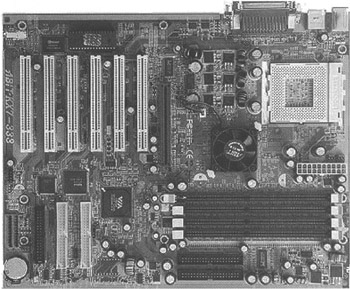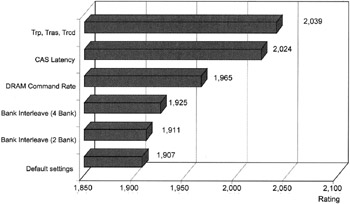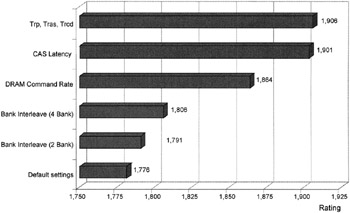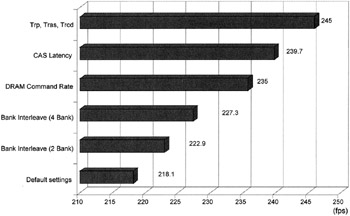Performance of a System with DDR266
Performance of a System with DDR266
The following system configuration was used for testing:
-
Processor — AMD Athlon XP 1600+
-
Motherboard — Abit KX7-333 (AMD Athlon/Duron, Socket A, VIA KT333 chipset, DDR333/266 memory support, Ultra DMA/33/66/100) (Fig. 12.2)

Figure 12.2: KX7-333 motherboard from Abit -
Hard disk — IBM DTLA 307030, 30 GB
-
RAM — Samsung, 256 MB, PC2100, DDR SDRAM
-
Video adapter — MX440 Nvidia GeForce4, 64 MB (Nvidia Detonator v28.32)
-
Sound card — Creative Live 5.1
-
Power supply unit — PowerMan, 250 W
-
Operating system — Windows 2000 SP1
The SiSoftware Sandra 2002 test was used to demonstrate the potential for optimal tuning of the memory subsystem. Besides this, a game test was performed using Quake III. To make the results more illustrative, one parameter was changed at a time. For each set of parameters, performance results are provided.
Default Settings
The default settings (with FSB and memory frequencies of 133 MHz) are as follows (Fig. 12.3):
-
Bank Interleave — Disable
-
DRAM Command Rate — 2T
-
DRAM CAS Latency — 2.5T
-
Precharge to Active (Trp) — 3T
-
Active to Precharge (Tras) — 6T
-
Active to CMD (Trcd) — 3T

Figure 12.3: DRAM Clock/Drive Control menu in BIOS Setup
|
Test |
Rating |
|---|---|
|
SiSoftware Sandra (integer) |
1,907 |
|
SiSoftware Sandra (floating point) |
1,776 |
|
Quake III (fastest) |
218.1 frames per second |
Bank Interleave
The Bank Interleave parameter manages access to the open memory banks. Possible values are as follows: disable, 2 Bank (sometimes 2-Way), and 4 Bank (sometimes 4-Way). The best performance is achieved when the 4 Bank value is chosen.
|
Test |
Rating |
|---|---|
|
SiSoftware Sandra (integer) |
1,911 |
|
SiSoftware Sandra (floating point) |
1,791 |
|
Quake III (fastest) |
222.9 frames per second |
|
Test |
Rating |
|---|---|
|
SiSoftware Sandra (integer) |
1,925 |
|
SiSoftware Sandra (floating point) |
1,806 |
|
Quake III (fastest) |
227.3 frames per second |
DRAM Command Rate
Using the DRAM Command Rate parameter, it is possible to specify manually the delays for data transfers between the chipset and the memory. The command (or CMD) rate has the greatest influence on the performance of the memory subsystem. Possible values are 1T and 2T. The greatest performance is achieved when the minimum value is set — 1T.
For the performance evaluation, the 1T setting was chosen. (The Bank Interleave option was set to 4 Bank.)
|
Test |
Rating |
|---|---|
|
SiSoftware Sandra (integer) |
1,965 |
|
SiSoftware Sandra (floating point) |
1,864 |
|
Quake III (fastest) |
235.0 frames per second |
Column Address Strobe (CAS) Latency
The CAS Latency parameter sets the delay (in clocks) specific for operations with RAM. The smaller this value, the faster RAM modules react to requests (i.e., the faster the memory subsystem). For performance, this is probably the most important parameter. Possible values are 2T and 2.5T.
For the performance evaluation, the value of 2T was chosen. (The previously selected settings were retained: Bank Interleave was 4 Bank, and DRAM Command Rate was 1T.)
|
Test |
Rating |
|---|---|
|
SiSoftware Sandra (integer) |
2,024 |
|
SiSoftware Sandra (floating point) |
1,901 |
|
Quake III (fastest) |
239.7 frames per second |
As a rule, the process of fine-tuning the memory subsystem has been accomplished at this stage. However, if you have high-quality memory modules, it is possible to achieve better performance by changing the following parameters: Precharge to Active (Trp), Active to Precharge (Tras), and Active to CMD (Trcd).
Trp, tras, and Trcd
The default values of the Trp, Tras, and Trcd parameters are as follows: 3T, 6T, and 3T. Decreasing the values of these parameters improves the performance of the memory subsystem. During the tuning process, the following values were set: Trp = 2T, Tras = 5T, and Trcd = 2T. (The previously selected settings were retained: Bank Interleave was 4 Bank, DRAM Command Rate was 1T, and CAS Latency was 2T.)
|
Test |
Rating |
|---|---|
|
SiSoftware Sandra (integer) |
2,039 |
|
SiSoftware Sandra (floating point) |
1,906 |
|
Quake III (fastest) |
245.0 frames per second |
As follows from the test results, decreasing the values for the Trp, Tras, and Trcd parameters improved performance about 7.5% using the SiSoftware Sandra 2002 test, and more than 12% using the Quake III game test.
Diagrams illustrating performance gain are presented in Figs. 12.4-12.6.

Figure 12.4: Performance as parameters are changed (SiSoftware Sandra, integer)

Figure 12.5: Performance as parameters are changed (SiSoftware Sandra, floating point)

Figure 12.6: Performance as parameters are changed (Quake III)






